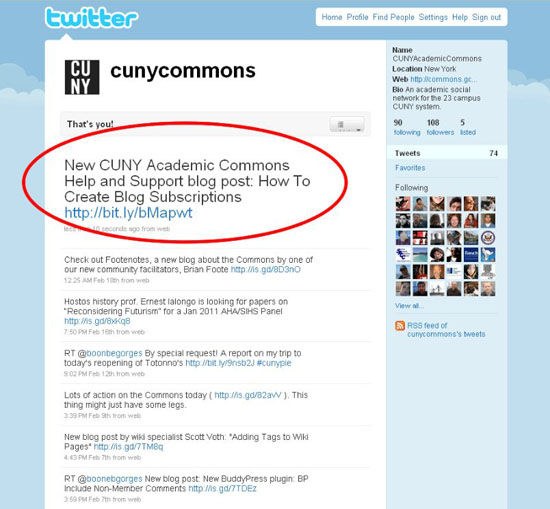From CUNY Academic Commons
Please add blogs and about education and technology (that aren’t on the CUNY Academic Commons) that you think your colleagues might find valuable.
bavatuesdays is the blog of Jim Groom (of UMW) who’s probably the best educational technologist in the country. Here are two online comments about him: “Generations from now, they won’t call it the Internet anymore. They’ll just say, “I logged on to the Jim Groom this morning,” and “Everything Jim Groom touches is gold. He’s the King Midas of the Internet.”
The Lapland Chronicles is the terrific blog of our leader Matt Gold. Read his blog to learn everything that’s going on in digital humanities and in technology in higher education. (KG).
Stephen’s Web is the blog of Stephen Downes, a is a leading voice in the areas of online learning, rich media, e-learning objects, and weblogs.
Learning and Innovation is the Cole Camplese’s blog and one of the most respected ones on the intersection of technology and education. He’s the Director of Education Technology Services at Penn State and he’s been writing about the impact of technology on teaching and learning for the past decade.
Tomorrow’s Professor Blog is a collaboration between MIT and Stanford that serves as “a place for discussion about teaching and learning, and general issues concerning higher education.”
incorporated subversion is “the online education blog” of James Farmer, the CEO of EduBlogs.
CAC.OPHONY is a blog on “communication-intensive instruction at the college level and its implications for students about to face the challenges of writing and speaking publicly in professional settings.” It’s written by the Fellows at Baruch’s Bernard L. Schwartz Communication Institute.
eLearningSpace is an extremely well-organized and user-friendly site that includes links to dozens of other blogs and important resource sites. Here’s the introduction: ” Staying current in elearning trends can be a daunting task. An educator must be aware of forces in business (for corporate elearning partnerships), education, and technology. It is important to select valuable, focused and trusted resources of information. Subscribing to a good listserv, visiting technology sites, reading elearning blogs, or relying on aggregators can significantly reduce the time spent staying in touch with new trends and issues.”
Creating Passionate Learners is the blog of a Google AI researcher and an expert on brain and metacognition.
Educause Blogs has blogs that include liks to podcasts and presentations that illustrate the topics being discussed.
ReadWriteWeb is an excellent source of information on all web 2.0 tools and e-Learning 2.0. The articles that the author includes don’t come from the e-learning profession, so they really represent clients and learners’ opinions.
Digital Campus is a biweekly discussion of how digital media and technology are affecting learning, teaching, and scholarship at colleges, universities, and libraries.
EdTechPost is a blog about technologies for learning, thinking, and collaborating in higher education.
Digital Digs is a blog in which Alex Reid discusses a variety of issues including new media, rhetoric, and composition; digital ethics and scholarship; and digital scholarship and tenure.
Futures of Learning is a blog about new media and learning. The members of the blog are part of a project, funded by the MacArthur Foundation, that is conducting an international survey of research in the field.
Mountebanke is the blog of Joe Ugoretz, the Director of Technology at the CUNY Graduate Center, Director of Learning and Teaching at McCauley Honors College, and the the creators of McCauley Honors College’s ePortfolio project.
e-Literate is the blog of Michael Feldstein, Principal Product Manager for Academic Enterprise Solutions at Oracle Corporation, in which he discusses online learning and learning management systems.
Dave Lester’s Finding America is the blog of Dave Lester, a “digital humanist” web developer at the Center for History and New Media at George Mason University who examines the way colleges and universities are using new technologies.
Interactive Media for Higher Education has the latest news and the author’s insights about interactive media, social networks, web 2.0, and student learning and recruitment.
abject learning is a blog about “open education” and the impact of Web 2.0.







